Occupants and households
On this page
Quick facts
- In 2019–20, there were around 802,000 occupants living in three of Australia’s main social housing programs (public housing, state owned and managed Indigenous housing (SOMIH) and community housing, the majority (70%) were in public housing.
- At 30 June 2020, there were 416,200 households in the four main social housing programs, increasing from 378,600 in June 2008.
- The number of households living in public housing decreased from 331,100 in 2008 to 289,600 in 2020.
- The proportion of households living in social housing in Australia decreased from 4.7% in 2010 to 4.2%, in 2020.
- The number of households in community housing nearly tripled (up 175%) from around 35,000 in 2008 to 96,400 in 2020; some of this growth related to the transfer of public housing dwellings to community housing.
- In 2020, over 4 in 10 (43%) households in public housing had been in their tenancies for 10 years or more.
Occupants in social housing
The term ‘Occupants’ refers to all those living in social housing programs (sometimes also referred to as tenants or household members). The following presents data on people living in public housing, SOMIH and community housing; data for Indigenous community housing were not available.
In 2019–20, there were around 802,000 people living in Australia’s 3 main social housing programs: public housing, state owned and managed Indigenous housing (SOMIH) and community housing (complete data were not available for all programs in Queensland and the Northern Territory).
Of the social housing occupants in 2019–20 (Supplementary table OCCUPANTS.1):
- 70% were in public housing (around 563,900 people)
- 23% were in community housing (around 188,200 people)
- 6% were in SOMIH (around 49,900 people).
The number of occupants living in social housing in Australia increased from 805,000 in 2013–14 to 819,500 in 2015–16, and has then declined to 802,000 in 2019–20.
State and territory
The location of social housing occupants across the states and territories has been relatively consistent over time. In 2019–20, 34% of social housing occupants were living in New South Wales, 18% in Victoria and 17% in Queensland. Considering the individual social housing programs, there have been some notable changes over time.
The proportion of occupants in community housing living in Victoria decreased from 24% in 2013–14 to 13% in 2019–20. In 2013–14, 12% of Australia’s community housing occupants were in Western Australia decreasing to 7% in 2019–20. It is important to note that there was a large increase in community housing occupants recorded in Queensland between 2013–14 and 2019–20, which impacted the proportion of occupants in the other State/Territories (Supplementary table OCCUPANTS.1).
Age and sex of occupants
Females made up the majority of all occupants across the three main social housing programs. In 2019–20, there were 312,100 (56%) females in public housing, 27,500 (55%) in SOMIH and 103,200 (55%) in community housing.
In 2019–20, key differences in the age profile of public and community housing include (Figure OCCUPANTS.1) (Supplementary table OCCUPANTS.2):
- The public housing program had an older age profile than community housing, with 36% of occupants aged 55 years and over in public housing compared with 32% in community housing.
- A similar proportion of public housing occupants (21%) were children aged under 15 years compared with community housing (21%).
- Across the other age groups, community housing had a higher proportion of occupants (21%) aged 25–44 compared with public housing (18%).
The SOMIH program had a different age profile from the other two programs, with just under half of occupants (49%) aged under 25 and around a third (31%) of all SOMIH household members aged 0–14. Around a third (32%) of SOMIH occupants were aged 25–49 years and a further 19% were aged over 50 (Figure OCCUPANTS.1) (Supplementary table OCCUPANTS.2).
Figure OCCUPANTS.1: Household members, by social housing program and age and sex, 2019–2020
Figure OCCUPANTS.1: Household members, by social housing program, age and sex, 2018–19. The butterfly graph shows the age profile of male and female household members in three social housing programs (public housing, community housing and SOMIH). In 2019–20, the highest number of female household members in public housing were aged 10–14 years of age (23,400) whereas the highest number of male household members were aged 10–14 years (24,600). For SOMIH, the highest number of female (3,200) and male (3,400) household members were aged 10–14 years.
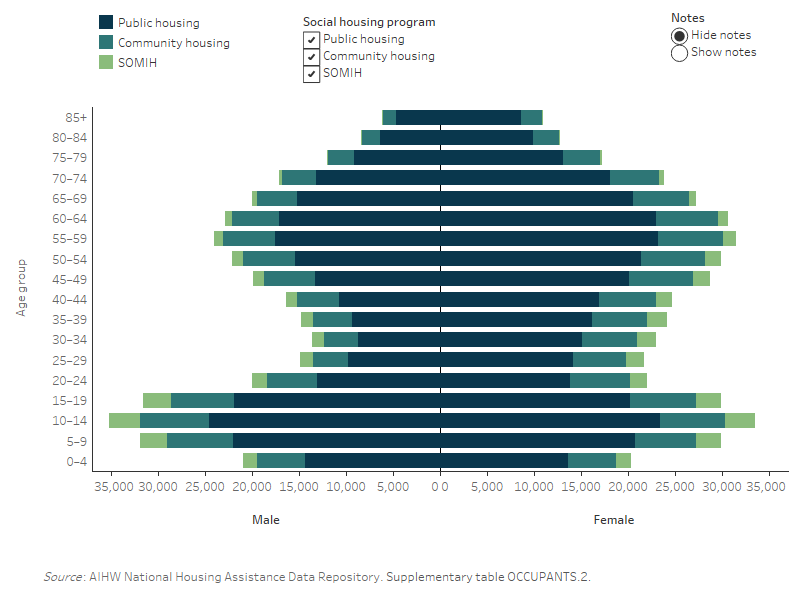
Indigenous occupants in social housing
In 2019–20, there were around 116,500 Indigenous Australian’s living in public housing and SOMIH. Of these occupants (Supplementary table OCCUPANTS.3):
- 71,800 occupants were living in public housing
- 44,700 occupants were living in SOMIH.
Changes over time
The number of Indigenous occupants in public housing and SOMIH has varied in recent years decreasing from 97,500 in 2013–14 to 87,700 in 2015–16, then increasing to 116,500 in 2019–20 (Supplementary table OCCUPANTS.3).
Occupant satisfaction
Results from the 2018 National Social Housing Survey (NSHS) show that occupant satisfaction with services from their housing provider is closely associated with the condition of their home, with satisfaction falling significantly as the number of structural problems increased (AIHW 2019). This relationship holds after accounting for a wide range of geographic, demographic and housing-related factors. There were also facilities in the home, time spent living in social housing, household composition, housing program and geographic variables such as state or territory.
Further information about occupant satisfaction with amenities, locations and services as well as the economic, health and social benefits of social housing, is published in the National Social Housing Survey 2018 (AIHW 2019). Two short supplementary reports were added in July 2019: Social housing stock transfers: tenant experiences in South Australia and Indigenous community housing: Queensland.
Households in social housing
At 30 June 2020, there were around 416,200 households living in the four main social housing programs across Australia. In these main social housing programs (Figure HOUSEHOLDS.1) (Supplementary table HOUSEHOLDS.1):
- 289,600 households (70%) were in public housing
- 96,400 households (23%) were in community housing
- 13,800 households (3%) were in SOMIH
- 16,400 households (4%) were in Indigenous community housing.
Figure HOUSEHOLDS.1: Households, by social housing program, at 30 June 2008 to 2020
Figure HOUSEHOLDS.1: Households, by social housing program, at 30 June 2008 to 2020. This vertical stacked bar graph shows the highest proportion of households from 2008 (88%) to 2020 (70%) were in public housing. SOMIH had the lowest proportion of households from 2008 (3.3%) to 2020 (3.3%). In 2020, community housing had the second highest proportion of households at 23% followed by Indigenous community housing (3.9%).
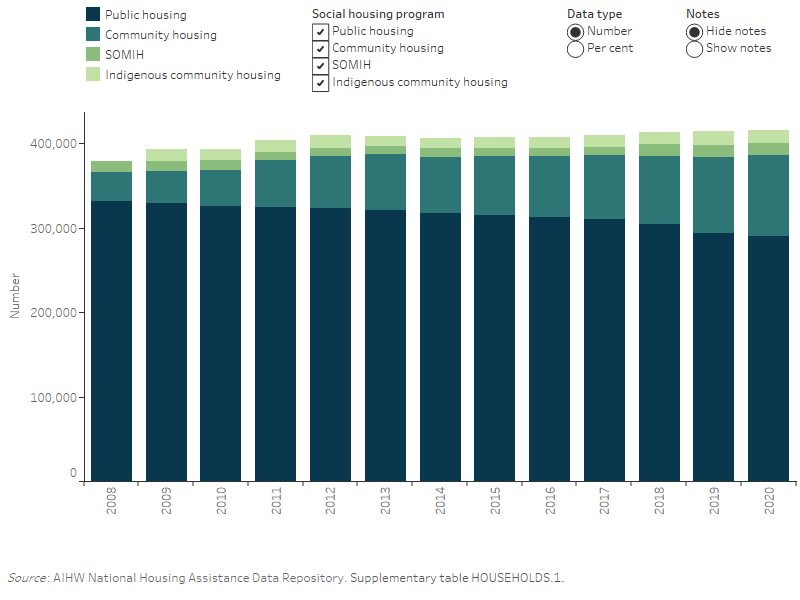
Households
Information about households is presented here for the four main programs: public housing, state owned and managed Indigenous housing (SOMIH), community housing and Indigenous community housing. Complete data were not available for all programs in some states and territories.
For the purposes of this analysis, a household is either an individual or a group of 2 or more related or unrelated people residing in the same dwelling. Information is presented about ongoing households, that is, those with a tenancy that has not concluded by 30 June in the reference year.
In 2017, some information was reported for the 5,000 dwellings that were transferred from public housing to SOMIH. From 2018, households and tenants information was reported for these dwellings.
Changes over time
Overall, the number of ongoing households in the four main social housing programs has fluctuated in recent years (between 378,600 at 30 June 2008 and 416,200 at 30 June 2020). The number of households in each of the programs have changed in this time. This likely reflects the policy focus towards growing the community housing sector and transferring ownership and/or management of public housing stock to community housing organisations (Figure HOUSEHOLDS.1) (Supplementary table HOUSEHOLDS.1).
The number of public housing households decreased from 331,100 at 30 June 2008 to 289,600 in 2020, offset by an increase in community housing households (from 35,000 to 96,400 over the same period) (Figure HOUSEHOLDS.1) (Supplementary table HOUSEHOLDS.1).
The number of Indigenous community housing has slightly increased from 14,200, in 2009 to 16,400 in 2020. Conversely, the number of SOMIH households decreased from 12,400 in 2008 to 9,600 households, at 30 June 2017. In 2018, when SOMIH household data for the Northern Territory were reported for the first time, the number of SOMIH households increased to 13,800. The number of households is comparable in 2020 at 13,800 households (Figure HOUSEHOLDS.1) (Supplementary table HOUSEHOLDS.1).
State and territory
The states and territories have different models of social housing provision. Of the households in social housing at 30 June 2020 (Figure HOUSEHOLDS.2) (Supplementary table HOUSEHOLDS.1):
- The vast majority of households in the Australian Capital Territory were in public housing (93%), with 7% in community housing.
- In contrast, 64% of social housing households in New South Wales were in public housing with 31% in community housing.
- For the Northern Territory, around 41% of households were in SOMIH and 40% were in public housing, with 4% in community housing and 15% in Indigenous community housing.
Changes in social housing stock
The change in the proportion of households in the social housing programs varied across the states and territories (Figure HOUSEHOLDS.2).
Due to changes in systems and processes, data for individual states and territories may not be comparable across reporting years. In addition, stock movements between the various programs, which changes the patterns of social housing over time may lead to differences of data. For example, in 2018–19 in South Australia and 2019–20 in New South Wales, a large number of dwellings were transferred from public housing and/or SOMIH to community housing. This affected the total number of households in these programs.
See the Data quality statements for more information.
Figure HOUSEHOLDS.2: Households, by social housing program and states and territories, at 30 June 2014 to 2020
Figure HOUSEHOLDS.2: Households, by social housing program and states and territories, at 30 June 2014 to 2019. Nationally, this vertical stacked bar graph shows that public housing had the highest number and proportion of households, from 2014 (317,000 or 78%) to 2020 (289,600 or 70%). The Australian Capital Territory had the highest proportion of public housing from 2014 (95%) to 2020 (93%). Tasmania had the highest proportion of community housing from 2014 (35%) to 2020 (48%). In 2020, of those states and territories that had a SOMIH program, the Northern Territory (41%), had the highest proportion of SOMIH households whereas Tasmania (1.6%) had the lowest proportion of SOMIH households.
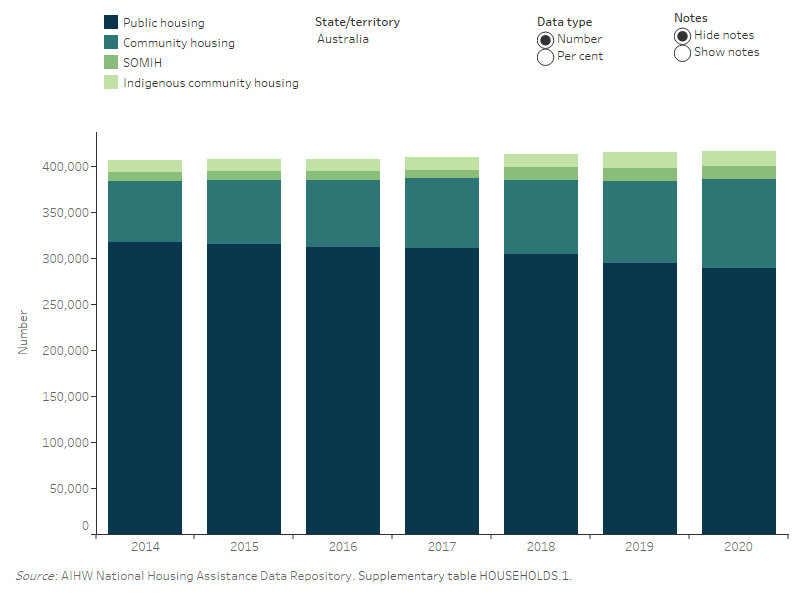
Key characteristics of households
At 30 June 2020, key characteristics of social housing households were (Supplementary table HOUSEHOLDS.3):
- almost two-thirds (62%) of main tenants were female, with 37% male
- main tenants aged 55–59 (11%, or 44,800 households) were the largest 5 year age group
- around 55,400 (14%) main tenants were aged 75 or older
- fewer than 1 in 5 (15%, or 58,200) included an Indigenous member
- almost 2 in 5 (35%, or 140,900) included a tenant with disability
- most households comprised single adults (51% or 203,500).
The vast majority of ongoing households were low income households; 95% of households in both public housing and SOMIH had a low income status. There was no low income data available for community housing (Supplementary table HOUSEHOLDS.3).
Length of household tenure
Stability of tenure can provide a foundation for social housing members to improve their economic participation, settle into and engage with the community, and support their health (Stone et al. 2015, SCRGSP 2021).
A substantial proportion of households in public housing and SOMIH remain in tenure for long periods of time. At 30 June 2020, about four in ten (43%) of public housing and 27% of SOMIH households had been in the same tenure for more than a decade. By contrast, 18% of community housing households had been in the same tenure for more than a decade and 8% had been in place for 6 months or less. This may be related to the length of time community housing dwellings have been available and the large transfer of public housing stock to community housing in 2018–19 (Figure HOUSEHOLDS.3) (Supplementary table HOUSEHOLDS.5).
Over time, the proportion of ongoing households with long-term tenure has increased. For public housing, there has been an increase in the proportion of households with a tenure length of 20–29 years or more, rising from 9% in 2011 to 13% in 2020. There has also been an increase in the proportion of community housing households with a tenure length of 5–9 years, growing from 13% in 2014 to 26% in 2020 (Figure HOUSEHOLDS.3) (Supplementary table HOUSEHOLDS.5).
Age groups
The length of tenure also differs considerably by the age of the main tenant in the household. At 30 June 2020, for public housing, shorter tenancy lengths (up to 1 year) were distributed more evenly across all age groups (ranging from 32% to 39%) with the exception of those aged 15–24 years (18%). By contrast, 32% of clients with a tenure length of 5–9 years and 76% of clients in tenancies for 30 or more years were 65+ years (Figure HOUSEHOLDS.3) (Supplementary table HOUSEHOLDS.4).
Figure HOUSEHOLDS.3: Households, by tenure length and social housing program, at 30 June 2020
Figure HOUSEHOLDS.3: Households, by tenure length, age group and social housing program, at 30 June 2019. This vertical stacked bar graph shows, across the social housing programs (public housing, community housing and SOMIH) the most common tenure for all age groups was 10–19 years (87,900). In community housing, the most common tenure length of those aged 15–24 years (2,300) was over 6 months to 1 year. Of those aged 45–54 (5,200) and 65+ (8,400), the most common tenure length was 5–9 years. The most common tenure length for all age groups for SOMIH (4,200) was 5–9 years; compared with public housing (72,000) where the most common tenure length was 10–19 years.
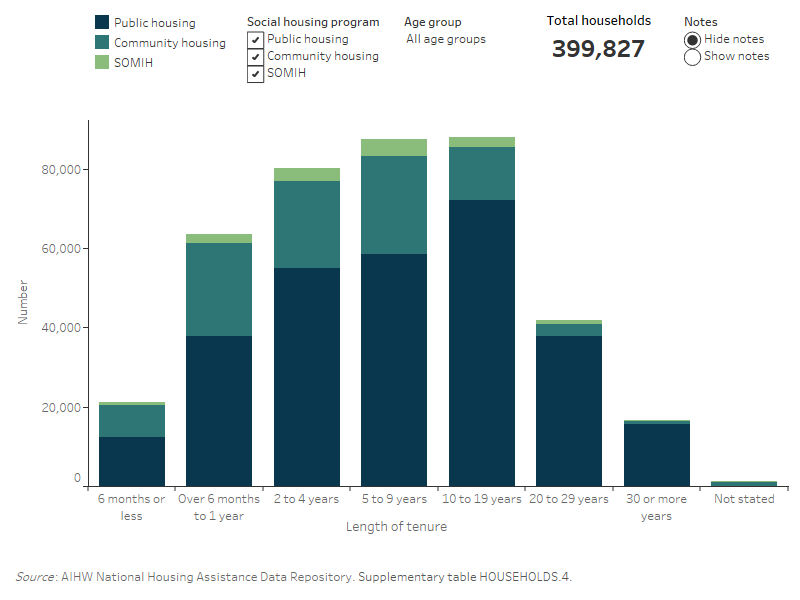
Indigenous households
The length of tenure for Indigenous households varied depending upon the housing program. Of these Indigenous households, at 30 June 2020 (Supplementary table HOUSEHOLDS.6):
- One in five (18%) public housing, 27% of SOMIH and 12% of community housing households had been in the same tenure for more than a decade.
- By contrast, 34% of public housing, 20% of SOMIH and 44% of community housing households had been in place for less than a year.
The high proportion of community housing households with a tenure of less than one year may be related to the shorter length of time these dwellings have been available.
Data for Indigenous community housing were not available.
Changes over time
Over time, the proportion of Indigenous households with long-term tenure has increased. At 30 June 2014 to 30 June 2020 (Supplementary table HOUSEHOLDS.6):
- The largest change in tenure length for community housing was households with a tenure length of 5–9 years, which increased from 10% to 19% of all Indigenous households.
- By contrast, for SOMIH households there was a decrease in households with a tenure length of 10–19 years, declining from 22% to 18% of Indigenous households.
Supply of social housing
There are various ways to look at the level of social housing in Australia. Considering the social dwelling stock in relation to overall dwelling stock is one way, however, using household counts is a suitable alternative.
In this analysis, the number of households in social housing comprises public housing, SOMIH, community housing and Indigenous community housing, sourced from the National Housing Assistance Data Repository. The total households in Australia estimate is sourced from the Australian Bureau of Statistics household projections series (ABS 2010; ABS 2015; ABS 2019).
In recent years, the number of social housing households has increased from 393,500 in 2010, to 416,200 at 30 June 2020 (Supplementary table SOCIAL SHARE.1). The number of total households in Australia over the same period increased from 8.4 million in 2010 to 9.8 million households in 2020 (ABS 2010; ABS 2019).
While the number of households in social housing has generally increased over time, it has not kept pace with the growth in the overall number of households in Australia. The proportion of social housing households has declined from 4.7% in 2010 to 4.2% in 2020 (Figure HOUSEHOLDS.4) (Supplementary table SOCIAL SHARE.1).
From 30 June 2014 to 30 June 2020, the share of social housing households varied between states and territories (Figure HOUSEHOLDS.4) (Supplementary table SOCIAL SHARE.1).
- In New South Wales, the proportion of social housing decreased from 5.0% in 2014 to 4.7% in 2020.
- The proportion of social housing households in Victoria declined from 3.5% in 2014 to 3% in 2020.
- In the Australian Capital Territory, the proportion of social housing declined from 7.6% in 2014 to 6.7% in 2020.
Figure HOUSEHOLDS.4: Social housing households as a proportion of all Australian households, by states and territories, at 30 June 2010 to 2020
Figure HOUSEHOLDS.4: Social housing households and all Australian households, at 30 June 2010 to 2020. This vertical bar graph shows that the proportion of social housing households remained stable over time, starting at 4.7% in 2010 and decreasing from a high of 4.8% in 2012 to 4.2% in 2020.
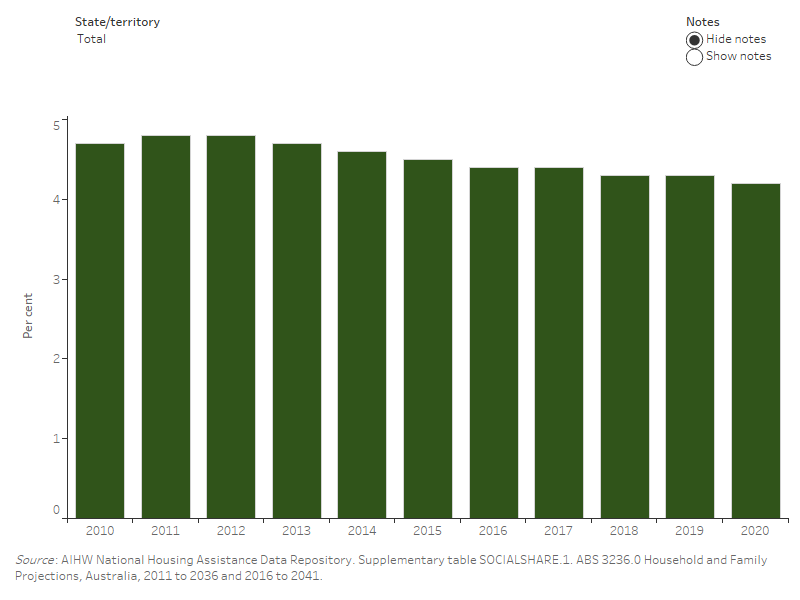
- ABS (Australian Bureau of Statistics) 2010. Household and Family Projections, Australia, 2006 to 2031. Cat. no. 3236.0. Canberra: ABS.
- ABS 2015. Household and Family Projections, Australia, 2011 to 2036. Cat. no. 3236.0. Canberra: ABS.
- ABS 2019. Household and Family Projections, Australia, 2016 to 2041. Cat. no. 3236.0. Canberra: ABS.
- AIHW 2019. National Social Housing Survey 2018. Cat. no. HOU 311. Canberra: AIHW.
- SCRGSP (Steering Committee for the Review of Government Service Provision) 2021. Report on Government Services 2021 – Housing (Part G, Section 18). Viewed 24 February 2021.
- Stone W, Sharam A, Wiesel I, Ralston L, Markkanen S and James A 2015. Accessing and sustaining private rental tenancies: critical life events, housing shocks and insurances. AHURI Final Report No.259. Melbourne: Australian Housing and Urban Research Institute.


